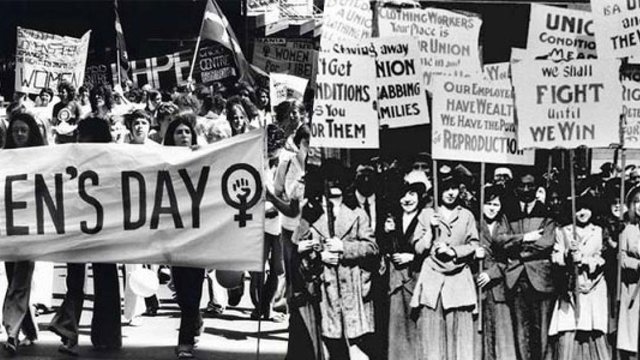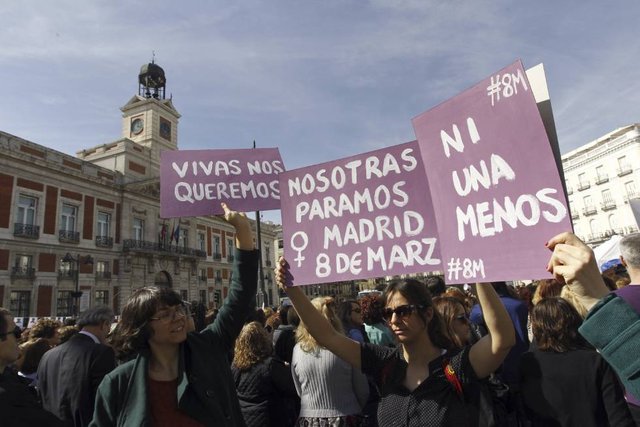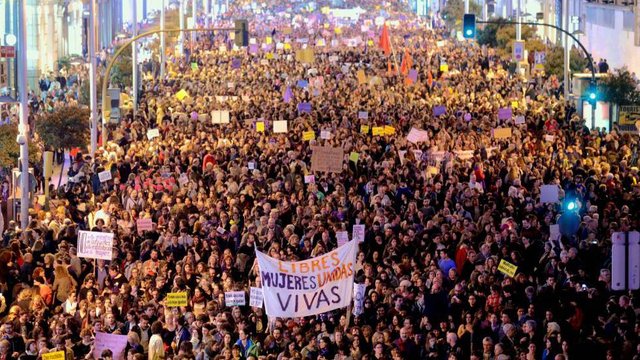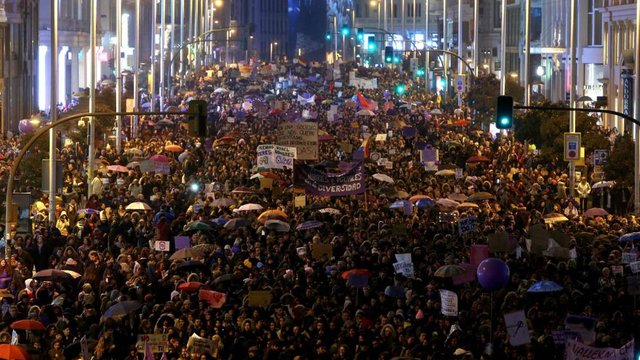Great feminist manifestation in Spain, one of the largest in history, 8M 2018.

A few years ago (2011) a revolutionary movement emerged in Spain that gave political scientists and experts from both inside and outside the country a chance to speak for several years. Magnitudes of people, especially young people, camped for days at the Puerta del Sol in Madrid, calling for greater social justice for all. A small group of women tried to raise a banner in the central plaza of Madrid with the slogan "the revolution will be a feminist", most people came up, a guy tore the poster and shouted "outside, outside," Finally they ended up expelled. The message they wanted to provide did not represent a great number or magnitude of women.
Yesterday, 8M, International Women's Day. All the expectations of the mobilization overflowed, and it is difficult to calculate the numerical impact of a movement, of demonstrations and a general strike, which have caught the attention of the media inside and outside the country.
As it is well known by all, the war of numbers is that, a war with an exact answer unattainable when we speak of such great magnitudes. But yesterday Spain could have broken a world record: that of the most numerous feminist call in the history of mankind. It is necessary to make an indicative calculation to know how many Spaniards left yesterday to the streets. To know if this country is, as it seems, the vanguard of the movement worldwide.
- Analyzing the adhesion to the strike:
On the one hand we have the figures of the strike-break, which could help us to calculate very well the minimum percentage of people who identify with the cause and who would end up afterwards approaching some act. We know that CCOO and UGT have given as official figure 5.9 million workers who supported the strike. We also know that union figures do not usually correspond to the reality of the strike follow-up. To put in perspective, in the previous general strike, in November 2012, these unions estimated the follow-up by 75%, 9 million workers, when the Administration estimated the internal follow-up at 52%.
The figures for the monitoring of unemployment by sectors and communities among the civil service during this feminist strike have been immensely varied, reaching 70% among teachers in Galicia and 1% in La Rioja. It was a general strike and open to both genders, but we must bear in mind that we would have to deduct technically 50% of the population, the male, to make the balance.
These follow-up figures of between 10 and 25% in the Administration seem stable enough within the public sector, a much safer workplace than the private sector. Women, as we know, tend to be more precarious at work, which also makes it much more difficult to support strikes.
This was not a general strike either because of the shyness of the two main unions when calling 24 hours a day. Claiming the break at 2 hours per shift, as well as appealing to feminist sentiment, conveyed the feeling that the call was a minor issue.
In short, we do not really know how many people have supported the strike in any of its formulas. Six million women strikers seems an unbelievable number (one million, a million and a half, could be a closer number). But now we go with the demonstrations.

Quantifying the 8M feminist ocean
During these weeks, El Salto has followed up on all the points where there were events called for this March 8. 123 demonstrations, 192 concentrations and 185 actions (although it seems that they escaped some concentrations in his recount, judging by the comments of the news). The perspective of this plurality of sources already makes us see the difficult magnitude of the count of the follow-up of the strike.
We have collected the attendance figures of delegations, police bodies and convenors of the demonstrations in fourteen of the main municipalities of Spain, totaling ten million of the population of 46 million in Spain, and we have weighted the results. Knowing the monitoring in the cities is also a particularly reliable measure in our country, since the concentration of life in large cities is very marked if we compare ourselves with other neighboring territories: our fields are especially depopulated.
For ten of these cities we have taken directly the figures of the police, but for the four of the most populated municipalities of our country that figure is not enough. As we know, there is often a huge disparity in quantification between organizers and public institutions.
The great demonstrations of Valencia, Zaragoza and especially Barcelona and Madrid, where floods of unquantifiable people appear, allow political wars. It is difficult to accept the figure of the Delegation of the Government of 170,000 attendees yesterday in Madrid when, seeing the images of the past, there were a million and a half people attending the march by Miguel Ángel Blanco. The same thing, if we compare the images of what according to Guardia Urbana were 200,000 people in Barcelona yesterday with respect to what they tell us when the Diada is manifested.
Nor is it credible that there were a million or a million and a half people in Madrid yesterday, as the regional delegation of the March 8 Commission has said. Not even the 600,000 that were in Barcelona. Faced with impossible figures, we opted for an average pulling down. 500,000 people in Madrid, 300,000 for Barcelona, 100,000 for Zaragoza and 100,000 in Valencia.

Five million people More than 10% of the Spanish population. The figure (even being estimated) shines even more if we compare it, as was indicated at the beginning of the article, with what the feminist movement has been historically, something usually minority and with which very few people identified.
The United States breastfed last year with its Women's March. Images of hundreds of thousands of women marching through New York or Washington went around the world. Vox and Washington Post made detailed post-march counts, and the most accurate estimate put the follow-up at 4.2 million. In a country with 323 million citizens. 1.3% of citizen protesters.
So yes, it seems that Spain has given life to the largest feminist national manifestation in history. In spite of everything, we can not forget that there have been other important feminist marches in the past, such as Hyde Park in 1908 (about 300,000 people), the Women's March in Pretoria in 1956 (20,000) or the Million Mom March in 2000. (950,000). Not all periods and contexts are comparable, which, although less seconded, we can not underestimate the importance of those acts in which the difficulty to go out was much greater.
What is undeniable, as we are also seeing now with the reactions of the politicians of Spain, is that the mobilization of yesterday was a paradigm shift. Metroscopia already warned him days before, 82% of Spaniards saw enough reasons for the feminist strike on Thursday, March 8. Feminism is an absolutely incontestable force in Spain.
